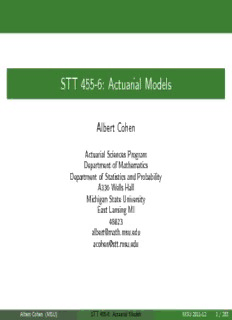
STT 455-6: Actuarial Models PDF
Preview STT 455-6: Actuarial Models
STT 455-6: Actuarial Models Albert Cohen ActuarialSciencesProgram DepartmentofMathematics DepartmentofStatisticsandProbability A336WellsHall MichiganStateUniversity EastLansingMI 48823 [email protected] [email protected] AlbertCohen (MSU) STT455-6:ActuarialModels MSU2011-12 1/283 Copyright Acknowledgement Many examples and theorem proofs in these slides, and on in class exam preparation slides, are taken from our textbook ”Actuarial Mathematics for Life Contingent Risks” by Dickson,Hardy, and Waters. Please note that Cambridge owns the copyright for that material. No portion of the Cambridge textbook material may be reproduced in any part or by any means without the permission of the publisher. We are very thankful to the publisher for allowing posting of these notes on our class website. Also, we will from time-to-time look at problems from released previous Exams MLC by the SOA. All such questions belong in copyright to the Society of Actuaries, and we make no claim on them. It is of course an honor to be able to present analysis of such examples here. AlbertCohen (MSU) STT455-6:ActuarialModels MSU2011-12 2/283 Survival Models An insurance policy is a contract where the policyholder pays a premium to the insurer in return for a benefit or payment later. The contract specifies what event the payment is contingent on. This event may be random in nature Assume that interest rates are deterministic, for now Consider the case where an insurance company provides a benefit upon death of the policyholder. This time is unknown, and so the issuer requires, at least, a model of of human mortality AlbertCohen (MSU) STT455-6:ActuarialModels MSU2011-12 3/283 Survival Models Define (x) as a human at age x. Also, define that person’s future lifetime as the continuous random variable T . This means that x +T represents x x that person’s age at death. Define the lifetime distribution F (t) = P[T ≤ t] (1) x x the probabiliity that (x) does not survive beyond age x +t years, and it’s complement, the survival function S (t) = 1−F (t). x x AlbertCohen (MSU) STT455-6:ActuarialModels MSU2011-12 4/283 P[x < T ≤ x +t] (2) 0 = P[T > x] 0 and so F (x +t)−F (x) 0 0 F (t) = x 1−F (x) 0 (3) S (x +t) 0 S (t) = x S (x) 0 In general we can extend this to S (t +u) = S (t)S (u) (4) x x x+t Conditional Equivalence We have an important conditional relationship P[T ≤ t] = P[T ≤ x +t | T > x] x 0 0 AlbertCohen (MSU) STT455-6:ActuarialModels MSU2011-12 5/283 (3) S (x +t) 0 S (t) = x S (x) 0 In general we can extend this to S (t +u) = S (t)S (u) (4) x x x+t Conditional Equivalence We have an important conditional relationship P[T ≤ t] = P[T ≤ x +t | T > x] x 0 0 P[x < T ≤ x +t] (2) 0 = P[T > x] 0 and so F (x +t)−F (x) 0 0 F (t) = x 1−F (x) 0 AlbertCohen (MSU) STT455-6:ActuarialModels MSU2011-12 5/283 Conditional Equivalence We have an important conditional relationship P[T ≤ t] = P[T ≤ x +t | T > x] x 0 0 P[x < T ≤ x +t] (2) 0 = P[T > x] 0 and so F (x +t)−F (x) 0 0 F (t) = x 1−F (x) 0 (3) S (x +t) 0 S (t) = x S (x) 0 In general we can extend this to S (t +u) = S (t)S (u) (4) x x x+t AlbertCohen (MSU) STT455-6:ActuarialModels MSU2011-12 5/283 Conditions and Assumptions Conditions on S (t) x S (0) = 1 x lim S (t) = 0 for all x ≥ 0 t→∞ x S (t ) ≥ S (t ) for all t ≤ t and x ≥ 0 x 1 x 2 1 2 Assumptions on S (t) x d S (t) exists ∀t ∈ R dt x + lim t ·S (t) = 0 for all x ≥ 0 t→∞ x lim t2·S (t) = 0 for all x ≥ 0 t→∞ x The last two conditions ensure that E[T ] and E[T2] exist, respectively. x x AlbertCohen (MSU) STT455-6:ActuarialModels MSU2011-12 6/283 P[(0) survives beyond age 30] = S (30) = 1−F (30) 0 0 (cid:18) (cid:19)1 30 6 = 1− = 0.9532 120 P[(30) dies before age 50] = F (20) 30 (5) F (50)−F (30) 0 0 = = 0.0410 1−F (30) 0 S (65) P[(40) survives beyond age 65] = S (25) = 0 = 0.9395 40 S (40) 0 Example 2.1 Assume that F (t) = 1−(cid:0)1− t (cid:1)16 for 0 ≤ t ≤ 120. Calculate the 0 120 probability that (0) survives beyond age 30 (30) dies before age 50 (40) survives beyond age 65 AlbertCohen (MSU) STT455-6:ActuarialModels MSU2011-12 7/283 Example 2.1 Assume that F (t) = 1−(cid:0)1− t (cid:1)16 for 0 ≤ t ≤ 120. Calculate the 0 120 probability that (0) survives beyond age 30 (30) dies before age 50 (40) survives beyond age 65 P[(0) survives beyond age 30] = S (30) = 1−F (30) 0 0 (cid:18) (cid:19)1 30 6 = 1− = 0.9532 120 P[(30) dies before age 50] = F (20) 30 (5) F (50)−F (30) 0 0 = = 0.0410 1−F (30) 0 S (65) P[(40) survives beyond age 65] = S (25) = 0 = 0.9395 40 S (40) 0 AlbertCohen (MSU) STT455-6:ActuarialModels MSU2011-12 7/283
Description: